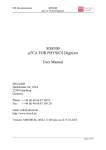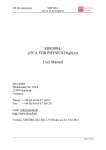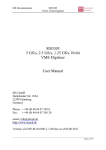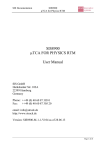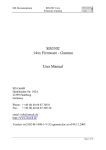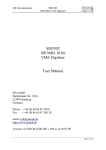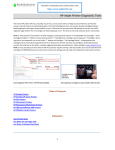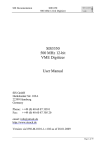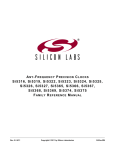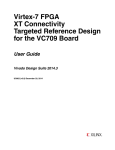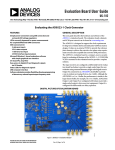Download SIS8300 µTCA FOR PHYSICS Digitizer User Manual
Transcript
SIS Documentation SIS8300 µTCA 16-bit Digitizer SIS8300 µTCA FOR PHYSICS Digitizer User Manual SIS GmbH Harksheider Str. 102A 22399 Hamburg Germany Phone: ++49 (0) 40 60 87 305 0 Fax: ++49 (0) 40 60 87 305 20 email: [email protected] http://www.struck.de Version: SIS8300-M-0201-001-V200.doc as of 28.06.11 Page 1 of 45 SIS Documentation SIS8300 uTCA for Physics Digitizer Revision Table: Revision 0.01 0.02 0.03 0.04 0.05 0.06 0.07 1.00 1.01 1.02 1.03 2.00 Page 2 of 45 Date 21.06.10 18.08.10 25.08.10 27.08.10 17.09.10 18.09.10 06.10.10 08.10.10 22.10.10 19.10.10 17.03.11 28.06.11 Modification Based on AG notes Clock Distribution Vendor Id./PCI Id. Register inlays Add registers Front panel description RTM connectors DAC comment V0103 Firmware Release JTAG over PCIe Index entry JTAG parallel load note Changes with new PCB version V2 - changed DAC interface - add FPGA CRC check register RTM management chapter SIS Documentation SIS8300 µTCA 16-bit Digitizer - Table of contents 1 2 3 4 5 6 7 8 9 Table of contents....................................................................................................................................... 3 Introduction .............................................................................................................................................. 5 1.1 Related documents............................................................................................................................. 5 Design ...................................................................................................................................................... 6 2.1 Functionality ..................................................................................................................................... 6 2.2 Block Diagram .................................................................................................................................. 6 2.3 Platform Management........................................................................................................................ 7 2.4 Clock Distribution ............................................................................................................................. 8 Jumper/Connector Pin Assignments........................................................................................................... 9 3.1 CON100 JTAG.................................................................................................................................. 9 3.2 J604 Watchdog Reset......................................................................................................................... 9 3.3 J32 AVR JTAG ................................................................................................................................. 9 LEDs ...................................................................................................................................................... 10 4.1 AMC LEDs ..................................................................................................................................... 10 4.2 Front Panel LEDs ............................................................................................................................ 10 4.3 SMD LEDs...................................................................................................................................... 10 Front panel.............................................................................................................................................. 11 5.1 Harlink LVDS In-/Outputs............................................................................................................... 12 5.2 SMA Clock Input ........................................................................................................................... 12 Board Layout .......................................................................................................................................... 13 Firmware Description.............................................................................................................................. 14 7.1 Address Map ................................................................................................................................... 14 7.2 Memory buffer ................................................................................................................................ 16 7.3 ADC Sample Logic ......................................................................................................................... 17 7.4 Module Id. and Firmware Revision register...................................................................................... 18 7.5 Serial Number register ..................................................................................................................... 18 7.6 XILINX JTAG register .................................................................................................................... 19 7.7 XILINX Virtex5 Error Detection register ......................................................................................... 19 7.8 User Control/Status register ............................................................................................................ 20 7.9 ADC Acquisition Control/Status register......................................................................................... 21 7.10 ADC Sample Control register .......................................................................................................... 22 7.11 MLVDS Input/Output Control register............................................................................................. 23 7.12 Harlink Connector Input/Output Control register.............................................................................. 24 7.13 Clock Distribution Multiplexer control register ................................................................................ 25 7.13.1 Clock Multiplexer input signal assignments.............................................................................. 26 7.14 Clock Distribution AD9510 Serial Interface (SPI) interface register (0x41, read/write) ..................... 27 7.15 Clock Multiplier IC SI5326 SPI interface register............................................................................ 29 7.16 DAC Control register (0x45, read/write) .......................................................................................... 30 7.17 DAC Data register (0x46, read/write)............................................................................................... 30 7.18 ADC Serial Interface (SPI) interface register (0x48, read/write)........................................................ 31 7.19 ADC Input Tap delay registers (0x49).............................................................................................. 32 7.20 Virtex 5 System Monitor registers.................................................................................................... 32 7.21 Trigger setup register registers ......................................................................................................... 33 7.22 Trigger Threshold registers .............................................................................................................. 34 7.22.1 Trigger Threshold .................................................................................................................... 34 7.22.2 FIR Trigger Threshold.............................................................................................................. 35 7.23 Memory Sample Start Address / Actual Sample Address registers .................................................... 36 7.24 Sample Length register .................................................................................................................... 37 7.25 Ringbuffer Pretrigger Delay register................................................................................................. 37 RTM management................................................................................................................................... 38 Appendix ................................................................................................................................................ 39 9.1 Power Consumption......................................................................................................................... 39 9.2 Ordering options.............................................................................................................................. 39 9.3 RTM/Zone 3 connectors J75 and J76 ............................................................................................... 40 9.3.1 J75 connector pin assignments.................................................................................................. 40 9.3.2 J76 connector pin assignments.................................................................................................. 41 Page 3 of 45 SIS Documentation SIS8300 uTCA for Physics Digitizer 9.3.3 Note on AC/DC input stage selection........................................................................................ 41 9.4 RTM connector schematics.............................................................................................................. 43 10 Index................................................................................................................................................... 44 Page 4 of 45 SIS Documentation 1 SIS8300 µTCA 16-bit Digitizer Introduction The SIS8300 is a ten 10 channel 125 MS/s digitizer with 16-bit resolution according to the for Physics draft standard. uTCA SIS8300 with SFPs installed As we are aware, that no manual is perfect, we appreciate your feedback and will incorporate proposed changes and corrections as quickly as possible. The most recent version of this manual can be obtained by email from [email protected], the revision dates are online under http://www.struck.de/manuals.html . Note 1: It is PICMG‘s policy to prohibit claims of compliance with respect to a specification under development. Any such claims must be understood as applying to a draft, which is subject to change Note 2: The SIS8300 is developed in co-operation with DESY under ZIM grant 2460101MS9 (ZIM: Zentrales Innovationsprogramm Mittelstand) 1.1 Related documents A list of available firmware designs can be retrieved from http://www.struck.de/sis8300firm.html Page 5 of 45 Struck Documentation 2 SIS8300 uTCA for Physics Digitizer Design The central building block of the SIS8300 card is a Xilinx Virtex 5 FPGA. It holds the 4 lane PCI Express interface and is in control of all active components. 2.1 Functionality The key properties of the SIS8300 card are listed below. Double size µTCA for Physics Board 4 Lane PCI Express Interface Dual SFP Card Cage for optional Multi Gigabit Link Xilinx Virtex 5 FPGA DDR2 Memory Interface 4 x 1 GBit default DDR2 memory Atmega128 IPMI External Clock and Trigger Inputs Frontpanel digital I/O (4in/4 out) on Harlink Connectors RTM ADC Analog Inputs, I2C-Bus 10 ADC Channels 125MS/s, 16-Bit 2 DAC Channels 250MS/s, 16-Bit Clock distribution with phase shifting 4 M-LVDS µTCA Ports 2 µTCA Clocks 2.2 Block Diagram A simplified block diagram of the SIS8300 is shown below. Page 6 of 45 Struck Documentation 2.3 SIS8300 uTCA for Physics Digitizer Platform Management The management code of the SIS8300 is implemented in an Atmel Atmega1281-16MU microcontroller and can be upgrade in field over connector J32 (see section 3.3). Page 7 of 45 Struck Documentation SIS8300 uTCA for Physics Digitizer 2.4 Clock Distribution The clock distribution scheme of the SIS8300 is illustrated below. #2 2 0 MUX C 1 MUX E 1 3 3 2 0 ADCLK925 ADCLK925 MUX A MUX B 1 2 0 3 1 2 Ch9 T ADC ADC T FPGA CLK05 ADC ADC T T #1 3 ADC ADC µRTM SI5324 AD9510 0 1 FPGA CLK69 AD9510 MUX D 3 2 ADC ADC ADC ADC Ch1 Ch0 0 RTM_CLK0 RTM_CLK2 CLK1 CLK2 Backplane ADCLK925 ADCLK946 ADCLK925 ADCLK925 ADCLK946 EXTCLKB HARLINK ADCLK925 Quartz EXTCLKA SMA RTM_CLK1 Page 8 of 45 Struck Documentation SIS8300 uTCA for Physics Digitizer 3 Jumper/Connector Pin Assignments The following subsections describe the pin assignments of jumpers and connectors. 3.1 CON100 JTAG The SIS8300’s on board logic can load its firmware from a serial PROM, via the JTAG port on connector CON100, PCI Express or via the MMC. Hardware like the XILINX HW-USB-JTAG in connection with the appropriate software will be required for in field JTAG firmware upgrades. CON100 is a 2mm (i.e. metric) 14 pin header that allows you to reprogram the firmware of the SIS8300 board with a JTAG programmer. The pin out is shown in the schematic below. It is compatible with the cable that comes with the XILINX HW-USB-II-G-JTAG platform cable. CON100 can be found at the right bottom side of the board. Note 1: The board has to be powered for reprogramming over JTAG Note 2: The FPGA uses 8-bit parallel mode to load the firmware from the serial PROM. Make sure to check the 'Parallel Load' box in Impact when specifying the programming properties for the PROM. 3.2 J604 Watchdog Reset J604 can be found next to the left upper edge of U500 (largest chip on the card). With J604 closed the boards watchdog reset is connected to the reset logic. J604 should be opened for JTAG firmware programming. 3.3 J32 AVR JTAG This 10-pin header is used to connect to the JTAG of the Atmel Atmega128 microcontroller providing the IPMI/MCH functionality of the SIS8300. Page 9 of 45 Struck Documentation 4 SIS8300 uTCA for Physics Digitizer LEDs 4.1 AMC LEDs The AMC LEDs are implemented according to the standard. 4.2 Front Panel LEDs The SIS8300 in Gigalink stuffing option has 4 green front panel LEDs. LED name A U L1 L2 Function in Gigalink design PCI Express Access User LED PCIe Link up (Optical Link 1 up) ADC Sampling active (Optical Link 2 up) 4.3 SMD LEDs A number of surface mount red LEDs are on the SIS8300 to visualize part of the board status. LED designator D20A D20B D20C D20D D20E D20F D20G D20H D21D D105A D105B D110A D110B Page 10 of 45 LED comment S1 S2 S3 S4 S5 S6 S7 S8 READY TX FAULT 1 RX LOS 1 TX FAULT 2 RX LOS 2 Function Firmware dependent Firmware dependent Firmware dependent Firmware dependent Firmware dependent Firmware dependent Firmware dependent Firmware dependent FPGA ready Link 1 transmitter fault Link 1 receiver loss of signal Link 2 transmitter fault Link 2 receiver loss of signal Struck Documentation SIS8300 uTCA for Physics Digitizer 5 Front panel The SIS8300 is a µTCA for Physics board. A sketch of the front panel is shown below. Page 11 of 45 Struck Documentation SIS8300 uTCA for Physics Digitizer 5.1 Harlink LVDS In-/Outputs The Harlink LVDS Output and Input connectors have 5 signals each. The Clock signal to the left hand side is marked with C and the other 4 signals are labelled with 1-4. Top Bottom Clock P N 1 P N 2 P N 3 P N 4 P N 5.2 SMA Clock Input The front panel SMA clock input is designed to accept a maximum peak to peak signal level of 3V into 50 Ohms. The clock input signal is coupled to the internal logic via a capacitor. The schematic of the input stage is shown below. Page 12 of 45 Struck Documentation SIS8300 uTCA for Physics Digitizer 6 Board Layout A print of the silk screen of the component side is shown below. Connector types The used connectors are listed in the table below. Designator CON100 CON200 CON301 CON302 CAGE105 J10 J32 J75 J76 J77 J209 J205 J604 Function JTAG Clock In DAC 1 Out DAC 2 Out SFP Cage, 2 Ports AdvancedMC JTAG Atmega RTM RTM RTM Keying Trigger & Clock Out Trigger & Clock In Watchdog Manufacturer Molex JYEBAO JYEBAO JYEBAO TYCO HARTING SAMTEC ERNI ERNI TYCO HARTING HARTING SAMTEC Part Number 87831-1420 SMA8400A1-9000 SMA8400A1-9000 SMA8400A1-9000 1761014-1 16211701301000 HTSW-105-26-G-D ERmetZD-10x3P-FEM ERmetZD-10x3P-FEM (*) 27 21 121 8000 27 21 121 8000 HTSW-102-26-G-S Note (*): The used Key may depend on the hardware configuration of the SIS8300 Page 13 of 45 Struck Documentation SIS8300 uTCA for Physics Digitizer 7 Firmware Description 7.1 Address Map Following 32-bit addresses are implemented Offset 0x000 0x001 0x002 0x003 Access R R R/W R 0x004 R/W User Control/Status register (JK) 0x010 0x011 0x012 0x013 R/W R/W R/W R/W ADC Acquisition Control/Status register ADC Sample Control register MLVDS Input/Output Control register Harlink Connector Input/Output Control register 0x014 0x015 0x016 0x017 R/W R/W R/W R/W free free free free 0x40 0x41 0x42 R/W R/W R/W Clock Distribution Multiplexer control register Clock Distribution IC AD9510 SPI interface register Clock Multiplier IC SI5326 SPI interface register 0x44 0x45 0x46 R/W R/W R/W reserved DAC Control register DAC Data register 0x48 0x49 R/W R/W ADC SPI Interface register ADC Input Tap delay register 0x90 0x91 0x92 R/W R/W R/W VIRTEX5_SYSTEM_MONITOR_DATA register VIRTEX5_SYSTEM_MONITOR_ADDR register VIRTEX5_SYSTEM_MONITOR_CTRL register 0x100 0x101 .. 0x109 R/W R/W ADC ch1 Trigger Setup register ADC ch2 Trigger Setup register R/W ADC ch10 Trigger Setup register 0x110 0x111 .. 0x119 R/W R/W ADC ch1 Trigger Threshold register ADC ch2 Trigger Threshold register R/W ADC ch10 Trigger Threshold register Page 14 of 45 Function Module Identifier/Firmware Version register Serial number register XILINX JTAG register XILINX Virtex5 configuration memory Error Detection register Struck Documentation SIS8300 uTCA for Physics Digitizer 0x120 0x121 .. 0x129 R/W R/W ADC ch1 Memory Sample Start Address / Actual Address register ADC ch2 Memory Sample Start Address / Actual Address register R/W ADC ch10 Memory Sample Start Address / Actual Address register 0x12A R/W ADC chx Sample Length Register 0x12B R/W ADC chx Ringbuffer Pretrigger Delay (0 to 2046) 0x12C 0x12D 0x12E 0x12F R/W R/W R/W R/W free free free free 0x200 0x201 0x202 0x203 0x204 R/W R/W R/W R/W R/W R/W R/W R/W R/W R/W R/W R/W R/W R/W R/W R/W R/W R/W R/W W DMA_READ_DST_ADR_LO32 DMA_READ_DST_ADR_HI32 DMA_READ_SRC_ADR_LO32 DMA_READ_LEN DMA_READ_CTRL 0x210 0x211 0x212 0x213 0x214 0x230 0x211 0x3ff DMA_WRITE_SRC_ADR_LO32 DMA_WRITE_SRC_ADR_HI32 DMA_WRITE_DST_ADR_LO32 DMA_WRITE_LEN DMA_WRITE_CTRL MEMORY test Mode register DMA_WRITE_SRC_ADR_HI32 Bit 0 = 1: Master Reset (reset all registers) Page 15 of 45 Struck Documentation SIS8300 uTCA for Physics Digitizer 7.2 Memory buffer The structure of the memory buffer with 512 MByte (i.e. 4 x 1 GBit memory chips) is illustrated below. Page 16 of 45 Struck Documentation 7.3 SIS8300 uTCA for Physics Digitizer ADC Sample Logic Page 17 of 45 Struck Documentation 7.4 SIS8300 uTCA for Physics Digitizer Module Id. and Firmware Revision register #define SIS8300_IDENTIFIER_VERSION_REG 0x00 This register holds the module identifier (SIS8300) and the firmware version and revision. BIT access Name 31-16 RO Function Module Identifier 0x8300 Firmware Version 1..255 Firmware Revision 1..255 FFFF0000 15-8 RO 0000FF00 7-0 RO 000000FF Example: The initial version of the SIS8300 reads 0x83000101 7.5 Serial Number register #define SIS8300_SERIAL_NUMBER_REG 0x01 This register holds the Serial Number of the module. BIT access Name 31-16 RO Function reserved FFFF0000 15-0 RO 0000FFFF Page 18 of 45 Serial Number 1..65535 Struck Documentation 7.6 SIS8300 uTCA for Physics Digitizer XILINX JTAG register #define SIS8300_XILINX_JTAG_REG 0x02 XILINX JTAG register This register is used in the firmware upgrade process over PCIe only. A TCK is generated upon a write cycle to this register. Bit 31 30 ... 4 3 2 1 0 write Function none ... ... none none none TMS TDI read Function TDO 1 x Shifted TDO 30 x Shifted TDO The read register function operates as a shift register for TDO. The content of the read register is shifted to the right by one bit with every positive edge of TCK and the status of TDO is transferred to Bit 30. Bit 31 reflects the current value of TDO during a read access. 7.7 XILINX Virtex5 Error Detection register #define SIS8300_XILINX_ECC_REG 0x03 XILINX Virtex5 configuration memory error detection register. Bit 31 30 ... 16 15 14 13 12 11 .. 1 0 read Function 0 0 0 Frame ECC output indicating a valid SYNDROME value 0 CRC Error ECC Error SYNDROME: Status bit 11 SYNDROME: Status bit 1 SYNDROME: Status bit 0 Page 19 of 45 Struck Documentation 7.8 SIS8300 uTCA for Physics Digitizer User Control/Status register #define SIS8300_USER_CONTROL_STATUS_REG 0x04 The control register is implemented as a selective J/K register, a specific function is enabled by writing a 1 into the set/enable bit, the function is disabled by writing a 1 into the clear/disable bit (which location is 16-bit higher in the register). An undefined toggle status will result from setting both the enable and disable bits for a specific function at the same time. The only function at this point in time is user LED on/off. On read access the same register represents the status register. Bit 31 30 29 28 27 26 25 24 23 22 21 20 19 18 17 16 15 14 13 12 11 10 9 8 7 6 5 4 3 2 1 0 write Function Clear reserved 15 (*) Clear reserved 14 (*) Clear reserved 13 (*) Clear reserved 12 (*) Clear reserved 11 (*) Clear reserved 10 (*) Clear reserved 9 (*) Clear reserved 8 (*) Clear reserved 7 (*) Clear reserved 6 (*) Clear reserved 5 (*) Clear reserved 4 (*) Clear reserved 3 (*) Clear reserved 2 (*) Clear reserved 1 (*) Switch off user LED (*) Set reserved 15 Set reserved 14 Set reserved 13 Set reserved 12 Set reserved 11 Set reserved 10 Set reserved 9 Set reserved 8 Set reserved 7 Set reserved 6 Set reserved 5 Set reserved 4 Set reserved 3 Set reserved 2 Set reserved 1 Switch on user LED (*) denotes power up default setting Page 20 of 45 read Function 0 0 0 0 0 0 0 0 0 0 0 0 0 0 0 0 Status reserved 15 Status reserved 14 Status reserved 13 Status reserved 12 Status reserved 11 Status reserved 10 Status reserved 9 Status reserved 8 Status reserved 7 Status reserved 6 Status reserved 5 Status reserved 4 Status reserved 3 Status reserved 2 Status reserved 1 Status User LED (1=LED on, 0=LED off) Struck Documentation 7.9 SIS8300 uTCA for Physics Digitizer ADC Acquisition Control/Status register #define SIS8300_ACQUISITION_CONTROL_STATUS_REG Bit 31 30 29 28 ... ... 17 16 15 12 11 10 9 8 7 6 5 4 3 2 1 0 write 0x10 /* rd/wr D32 */ read Status: DDR2 Memory OK Status: internal Sample Buffer Not Empty Status: internal Sample Logic Busy ‘1’ : Disable Sampling (Reset Sample Logic) ‘1’ : Arm Sampling (Start with next trigger) ‘1’ : Start Sampling immediately (Arm and Start/Trigger) Status: Arm for trigger (Wait for trigger) Status: Sampling Busy The power up default value is 0x0 Page 21 of 45 Struck Documentation SIS8300 uTCA for Physics Digitizer 7.10 ADC Sample Control register #define SIS8300_SAMPLE_CONTROL_REG 0x11 /* rd/wr D32 */ ADC channels can be disabled from storing data to memory by setting the corresponding disable bit in this register. Bit 31 30 29 28 ... ... 17 16 15 12 11 10 9 8 7 6 5 4 3 2 1 0 write Enable external Trigger Enable internal Trigger Disable Sampling Ch10 Disable Sampling Ch9 Disable Sampling Ch3 Disable Sampling Ch2 Disable Sampling Ch1 The power up default value is 0x0 Page 22 of 45 Struck Documentation SIS8300 uTCA for Physics Digitizer 7.11 MLVDS Input/Output Control register #define SIS8300_MLVDS_IO_CONTROL_REG Bit 31 30 .. 25 24 23 22 ... 17 16 15 14 ... 9 8 7 6 ... 1 0 0x12 /* rd/wr D32 */ Write Enable LVDS Output Bit 7 Enable LVDS Output Bit 6 Read Enable LVDS Output Bit 7 Enable LVDS Output Bit 6 Enable LVDS Output Bit 1 Enable LVDS Output Bit 0 LVDS Output Bit 7 LVDS Output Bit 6 Enable LVDS Output Bit 1 Enable LVDS Output Bit 0 LVDS Output Bit 7 LVDS Output Bit 6 LVDS Output Bit 1 LVDS Output Bit 0 LVDS Input 7 External Trigger Enable LVDS Input 6 External Trigger Enable LVDS Output Bit 1 LVDS Output Bit 0 LVDS Input 7 External Trigger Enable LVDS Input 6 External Trigger Enable LVDS Input 1 External Trigger Enable LVDS Input 0 External Trigger Enable LVDS Input 7 External Trigger falling edge LVDS Input 6 External Trigger falling edge LVDS Input 1 External Trigger Enable LVDS Input 0 External Trigger Enable LVDS Input Bit 7 LVDS Input Bit 6 LVDS Input 1 External Trigger falling edge LVDS Input Bit 1 LVDS Input 0 External Trigger falling edge LVDS Input Bit 0 Note: external trigger in signals are synchronized with the FPGA CLK05 Page 23 of 45 Struck Documentation SIS8300 uTCA for Physics Digitizer 7.12 Harlink Connector Input/Output Control register #define SIS8300_HARLINK_IO_CONTROL_REG Bit 31 30 .. 21 20 19 18 17 16 15 14 13 12 11 10 9 8 7 6 5 4 3 2 1 0 0x13 /* rd/wr D32 */ Write No function No function Read 0 0 No function No function Harlink Output 4 Harlink Output 3 Harlink Output 2 No function Harlink Input 4 External Trigger falling edge Harlink Input 3 External Trigger falling edge Harlink Input 2 External Trigger falling edge Harlink Input 1 External Trigger falling edge Harlink Input 4 External Trigger Enable Harlink Input 3 External Trigger Enable Harlink Input 2 External Trigger Enable Harlink Input 1 External Trigger Enable No function No function No function No function No function No function No function No function 0 0 Harlink Output 4 Harlink Output 3 Harlink Output 2 0 Harlink Input 4 External Trigger falling edge Harlink Input 3 External Trigger falling edge Harlink Input 2 External Trigger falling edge Harlink Input 1 External Trigger falling edge Harlink Input 4 External Trigger Enable Harlink Input 3 External Trigger Enable Harlink Input 2 External Trigger Enable Harlink Input 1 External Trigger Enable 0 0 0 0 Harlink Input 4 Harlink Input 3 Harlink Input 2 Harlink Input 1 Harlink Connector Input(1) : external trigger In Harlink Connector Output(1) : adc chx (or) trigger out Note: external trigger in signals are synchronized with the FPGA CLK05 Page 24 of 45 Struck Documentation SIS8300 uTCA for Physics Digitizer 7.13 Clock Distribution Multiplexer control register #define SIS8300_CLOCK_DISTRIBUTION_MUX_REG 0x40 The SIS8300 has 5 IDT ICS853S057 clock multiplexer chips, which are labelled A to E in the clock distribution schematic in section 2.4. The multiplexer control register holds the two select bits for the 5 multiplexer chips as shown in the table below. The assignment of the inputs to the resources (i.e. clock inputs) is listed in subsection 7.13.1. BIT access Name 31-12 R/W Function reserved no MUXE_SEL Multiplexer E select bits MUXD_SEL Multiplexer D select bits reserved no MUXC_SEL Multiplexer C select bits MUXB_SEL Multiplexer B select bits MUXA_SEL Multiplexer A select bits FFFFF000 11-10 R/W 00000C00 9-8 R/W 00000300 7-6 R/W 000000C0 5-4 R/W 00000030 3-2 R/W 0000000C 1-0 R/W 00000003 Page 25 of 45 Struck Documentation SIS8300 uTCA for Physics Digitizer 7.13.1 Clock Multiplexer input signal assignments 7.13.1.1 Multiplexer A Input Signals: U222 - Sel0 and Sel1 (MUX1A_SEL) = Multiplexer A select lines Sel1 0 0 1 1 Sel0 0 1 0 1 7.13.1.2 Selected Input - Net Name RTMCLK_0 TCLKB_0 TCLKA_0 OSC_CLK0 Clock source Description Clock 2 from µRTM card Clock 2 (Telecom Clock B) from AMC Connector (Backplane) Clock 1 (Telecom Clock A) from AMC Connector (Backplane) Onboard Clock chip (250MHz) Multiplexer B Input Signals: U223 - Sel0 and Sel1 (MUX1B_SEL) = Multiplexer B select lines Sel1 0 0 1 1 Sel0 0 1 0 1 7.13.1.3 Selected Input - Net Name RTMCLK_1 TCLKB_1 TCLKA_1 OSC_CLK1 Clock source Description Clock 2 from µRTM card Clock 2 (Telecom Clock B) from AMC Connector (Backplane) Clock 1 (Telecom Clock A) from AMC Connector (Backplane) Onboard Clock chip (250MHz) Multiplexer C Input Signals: U240 - Sel0 and Sel1 (MUXAB_SEL) = Multiplexer C select lines Sel1 0 0 1 1 Sel0 0 1 0 1 7.13.1.4 Selected Input - Net Name EXT_CLKB0 EXT_CLKA0 MUXA_CLK1 MUXB_CLK1 Clock source Description Clock from Harlink Connector “CI1-4 IN” (frontpanel) Clock from SMA Connector “CLK IN” (frontpanel) Multiplexer A Output Signal Multiplexer B Output Signal Multiplexer D Input Signals: U250 - Sel0 and Sel1 (MUX2A_SEL) = Multiplexer D select lines Sel1 0 0 1 1 Sel0 0 1 0 1 7.13.1.5 Selected Input - Net Name MUXA_CLK0 MUL_CLK1 EXT_CLKB1 EXT_CLKA1 Clock source Description Multiplexer A Output Signal Clock Multiplier (U242) Output 2 Signal Clock from Harlink Connector “CI1-4 IN” (frontpanel) Clock from SMA Connector “CLK IN” (frontpanel) Multiplexer E Input Signals: U251 - Sel0 and Sel1 (MUX2B_SEL) = Multiplexer E select lines Sel1 0 0 1 1 Sel0 0 1 0 1 Page 26 of 45 Selected Input - Net Name MUXB_CLK0 MUL_CLK0 EXT_CLKB2 EXT_CLKA2 Clock source Description Multiplexer B Output Signal Clock Multiplier (U242) Output 1 Signal Clock from Harlink Connector “CI1-4 IN” (frontpanel) Clock from SMA Connector “CLK IN” (frontpanel) Struck Documentation SIS8300 uTCA for Physics Digitizer 7.14 Clock Distribution AD9510 Serial Interface (SPI) interface register (0x41, read/write) #define SIS8300_AD9510_SPI_REG x41 /* read/write; D32 */ The parameters of the Clock Distribution IC AD9510 chips can be configured with the SPI (serial Peripheral Interface). ... ... 25 24 23 22 21 20 19 12 11 10 9 8 7 6 .. 1 0 Write Cmd Bit 1 Cmd Bit 0 Set “Function” Output Level Select “Function” synchronisation CLK AD9510 #2 Select Bit Read Cycle Bit read Write/Read Logic BUSY Flag Status of Set “Function” Output Level Status of Select “Function” synchronisation CLK Status AD9510 #2 Status AD9510 #1 Address Bit 12 Address Bit 11 RW CMD Bit 31 30 29 28 Address Bit 4 Address Bit 3 Address Bit 2 Address Bit 1 Address Bit 0 Write Data Bit 7 (MSB) Write Data Bit 6 Read Data Bit 7 (MSB) Read Data Bit 6 Write Data Bit 1 Write Data Bit 0 (LSB) Read Data Bit 1 Read Data Bit 0 (LSB) The power up default value is 0x20000000 Page 27 of 45 Struck Documentation SIS8300 uTCA for Physics Digitizer Command Bit (31:30) Explanation: Cmd Bit 1 0 0 1 Cmd Bit 0 0 1 0 1 1 Command No Function R/W CMD Function CMD Generates a pulse at the Function Input pin of the AD9510 which is synchronous to the selected clock. The clock selection is done via Bit 28 (Function Syn CLK). The actual function depends on the programming of the selected AD9510 Reserved Select “Function” synchronisation CLK Bit (28) Explanation: Bit 28 0 1 Clock Source PCI Clock FPGA CLK 69 Note: 1. enable READ by writing 0x90 to addr 0x0 2. and set Read Cycle Bit Note: Please refer to the SIS8300_AD9510_SPI_Setup routine as illustration and to the AD9510 documentation for details. Page 28 of 45 Struck Documentation SIS8300 uTCA for Physics Digitizer 7.15 Clock Multiplier IC SI5326 SPI interface register #define SIS8300_CLOCK_MULTIPLIER_SPI_REG x42 /* rd/wr */ Clock Multiplier IC SI5326 SPI interface register Several parameters of the Clock Multiplier SI5326 chip can be configured with the SPI (serial Peripheral Interface). Please refer to the documentation of the SI5326chip for details. Bit 31 30 29 ... 17 16 15 .. .. 8 7 .. .. 0 Write Cmd Bit 1 Cmd Bit 0 read Write/Read Logic BUSY Flag Reset, Decrement or Increment Cmd BUSY Flag Si53xx LOL Status Si53xx INT_C1B Status Instruction Byte Bit 7 Instruction Byte Bit 0 Address/Data Byte Bit 7 Read Data Bit 7 (MSB) .. Address/Data Byte Bit 0 Read Data Bit 1 Read Data Bit 0 (LSB) The power up default value is 0x0 Cmd Bit 1 0 0 1 1 Cmd Bit 0 0 1 0 1 Command Execute SPI Write/Read Cmd Reset Cmd Decrement Cmd Increment Cmd Reset Cmd: generates an 1us reset pulse Decrement Cmd: Increment Cmd: generates an 1us Skew Decrement pulse generates an 1us Skew Increment pulse Note: INC/DEC Time between consecutive pulses must be greater than 16ms ! Page 29 of 45 Struck Documentation SIS8300 uTCA for Physics Digitizer 7.16 DAC Control register (0x45, read/write) #define SIS8300_DAC_CONTROL_REG Bit 31 ... 16 15 … 12 11 10 9 8 7 6 5 4 .. 1 0 0x45 write /* read/write; D32 */ read DAC DCM Reset pulse 0: binary, 1: 2-er complement Test Mode Bit 1 Test Mode Bit 0 The power up default value is 0x0 Test Mode Bit 1 0 0 1 1 Test Mode Bit 0 0 1 0 1 DAC Test Mode Data from DAC Data register Ramp Test Mode ADC1/ADC2 -> DAC1/DAC2 reserved Note: ADC 1 Clock is used as DAC clock 7.17 DAC Data register (0x46, read/write) #define SIS8300_DAC_DATA_REG Bit 31 ... ... 16 15 ... ... 0 write DAC2 Data 15 DAC2 Data 0 DAC1 Data 15 DAC1 Data 0 The power up default value is 0x0 Page 30 of 45 0x46 /* read/write; D32 */ Struck Documentation SIS8300 uTCA for Physics Digitizer 7.18 ADC Serial Interface (SPI) interface register (0x48, read/write) #define SIS8300_ADC_SERIAL_INTERFACE_REG 0x48 /* read/write; D32 */ Several parameters of the ADC AD9268 chip can be configured with the SPI (serial Peripheral Interface). Please refer to the documentation of the ADC AD9268 chip for details. Bit 31 ... ... 26 25 24 23 22 21 20 19 write ADC Synch cmd read Write/Read Logic BUSY Flag 12 11 10 9 8 7 6 .. 1 0 Address Bit 4 Address Bit 3 Address Bit 2 Address Bit 1 Address Bit 0 Write Data Bit 7 (MSB) Write Data Bit 6 Read Data Bit 7 (MSB) Read Data Bit 6 Write Data Bit 1 Write Data Bit 0 (LSB) Read Data Bit 1 Read Data Bit 0 (LSB) ADC Select Mux Bit 2 ADC Select Mux Bit 1 ADC Select Mux Bit 0 Read Cmd Address Bit 12 Address Bit 11 The power up default value is 0x0 ADC Synch Cmd : generates an synch pulse with AD9510 #1 FPGA clock Page 31 of 45 Struck Documentation SIS8300 uTCA for Physics Digitizer 7.19 ADC Input Tap delay registers (0x49) #define SIS3305_ADC_INPUT_TAP_DELAY 0x49 The input tap delay registers are used to adjust the FPGA data strobe timing. Bit Function Bit 31 ... .. .. 12 11 10 9 8 7 6 .. 1 0 31-13 12 11 None ADC 9/10 ADC 7/8 Select Select 10 ADC 5/6 Select write 9 ADC 3/4 Select 8 ADC 1/2 Select 7-6 5-0 None Tap delay value ( x 78ps) read Tap Delay Logic BUSY Flag ADC 9/10 Select Bit ADC 7/8 Select Bit ADC 5/6 Select Bit ADC 3/4 Select Bit ADC 1/2 Select Bit Tap delay value Bit 7 Tap delay value Bit 6 Tap delay value Bit 7 Tap delay value Bit 6 Tap delay value Bit 1 Tap delay value Bit 0 Tap delay value Bit 1 Tap delay value Bit 0 7.20 Virtex 5 System Monitor registers #define SIS8300_VIRTEX5_SYSTEM_MONITOR_DATA_REG #define SIS8300_VIRTEX5_SYSTEM_MONITOR_ADDR_REG #define SIS8300_VIRTEX5_SYSTEM_MONITOR_CTRL_REG The Virtex 5 system monitor registers voltages of the FPGA on the SIS8300. give 0x90 0x91 0x92 access to temperature Refer to the sysmon.c routine and the Virtex 5 FPGA documentation for details. Page 32 of 45 and Struck Documentation SIS8300 uTCA for Physics Digitizer 7.21 Trigger setup register registers #define SIS8300_TRIGGER_SETUP_CH1_REG 0x100 /* rd/wr D32 */ 0x109 /* rd/wr D32 */ .. #define SIS8300_TRIGGER_SETUP_CH10_REG These read/write registers hold the 8-bit wide trigger pulse length (in sample clocks), the Peaking and Gap Time of the trapezoidal FIR filter. (Gap Time = SumG Time – Peaking Time) Bit Function 31 Reserved .. .. 26 Enable Trigger 25 GT trigger condition 24 FIR Trigger Mode 23 Puls Length bit 7 22 Puls Length bit 6 21 Puls Length bit 5 20 Puls Length bit 4 19 Puls Length bit 3 18 Puls Length bit 2 17 Puls Length bit 1 16 Puls Length bit 0 15 reserved 14 reserved 13 reserved 12 SumG bit 4 11 SumG bit 3 10 SumG bit 2 9 SumG bit 1 8 SumG bit 0 7 reserved 6 reserved 5 reserved 4 P bit 4 3 P bit 3 2 P bit 2 1 P bit 1 0 P bit 0 The power up default value reads 0x 00000000 Trigger Pulse Length SumG time (only FIR trigger) (time between both sums) Peaking time P (only FIR trigger) x+P Si i=x Si: Sum of ADC input sample stream from x to x+P P: Peaking time (number of values to sum) SumG: SumGap time (distance in clock ticks of the two running sums) The maximum SumG time: The minimun SumG time: Values > 16 will be set to 16 Value = 0 will be set to 1 16 (clocks) 1 (clocks) The maximum Peaking time: The minimun Peaking time: Values > 16 will be set to 16 Value = 0 will be set to 1 16 (clocks) 1 (clocks) Page 33 of 45 Struck Documentation SIS8300 uTCA for Physics Digitizer 7.22 Trigger Threshold registers #define SIS8300_TRIGGER_THRESHOLD_CH1_REG 0x110 /* rd/wr D32 */ 0x119 /* rd/wr D32 */ .. #define SIS8300_TRIGGER_THRESHOLD_CH10_REG These read/write registers hold the threshold values for the 10 ADC channels. 7.22.1 Trigger Threshold Bit Function 31-16 Threshold value OFF default after Reset: 15-0 Threshold value ON 0x0 A trigger output pulse is generated on two conditions: GT is set (GT) in trigger setup register: the trigger Out pulse will be issued if the actual sampled ADC value goes above the threshold value ON and OFF. A new Trigger Out Pulse will be suppressed until the ADC value goes below the threshold value OFF. GT is cleared (LT) in trigger setup register: the trigger Out pulse will be issued if the actual sampled ADC value goes below the threshold value ON and OFF. A new trigger Out pulse will be suppressed until the ADC value goes above the threshold value OFF. the trigger Out pulse will be issued if the actual sampled ADC value goes below the threshold value. GT: greater than LT: lower than Page 34 of 45 Struck Documentation SIS8300 uTCA for Physics Digitizer 7.22.2 FIR Trigger Threshold Bit Function 31-20 None default after Reset: 19-0 Trapezoidal threshold value 0x0 The value of the Sum (trapezoidal value) depends on the peaking time P. Therefore the selection of the value of the Trapezoidal threshold depends on P also. Trapezoidal value calculation: Trapezoidal value = (SUM2 – SUM1) Where x+P Si SUM1 = i=x x+P+sumG SUM2 = Sj j = x+sumG The FIR filter logic generates the Trapezoidal by subtraction of the two running sums. This implies, that the internal value of the trapezoid is on average 0. A trigger output pulse is generated: GT is set (GT): the Trigger Out Pulse will be issued if the actual trapezoidal value goes above the programmable trapezoidal threshold value GT is cleared (LT): the Trigger Out Pulse will be issued if the actual trapezoidal value goes below the negated programmable trapezoidal threshold value Page 35 of 45 Struck Documentation SIS8300 uTCA for Physics Digitizer 7.23 Memory Sample Start Address / Actual Sample Address registers #define SIS8300_SAMPLE_START_ADDRESS_CH1_REG .. #define SIS8300_SAMPLE_START_ADDRESS_CH10_REG 0x120 /* rd/wr D32 */ 0x129 /* rd/wr D32 */ The write function to these registers defines the memory start address. The value is given in 256-bit blocks. ADC ch1 Memory Sample Start Address / Actual Address register Bit 31-24 23-0 Write reserved Memory Sample Start Address (256-bit blocks) Function (16-bit word address x 16) default after Reset: 0x0 The power up default value is 0 Explanation (memory sample start address) The contents of the sample memory start address register is assigned as memory data storage address with the arm command (key address arm sampling) or with the enable command (key address enable sampling). The read function from these registers give the information of the actual sampling address for the given ADC channel. (at the moment: only valid if the logic is not busy!) The value is given in 256-bit Blocks (16bit word address x 16) Bit Read Function 31-24 reserved 23-0 Actual Sample Memory Address (in 256-bit Blocks) (16-bit word address x 16) the power up default value is 0 Page 36 of 45 Struck Documentation SIS8300 uTCA for Physics Digitizer 7.24 Sample Length register #define SIS8300_SAMPLE_LENGTH_REG 0x12A /* rd/wr D32 */ This register defines the number of sample blocks of each ADC Event or. The size of one sample block for each ADC channel is 256-bit (16 x 16-bit word). Bit Function 31-24 reserved default after Reset: 7-0 Sample Block Length 0x0 7.25 Ringbuffer Pretrigger Delay register #define SIS8300_PRETRIGGER_DELAY_REG 0x12B /* rd/wr D32 */ This register defines the number of pre trigger delay samples for all channels. The maximum pre trigger delay value is 2046. Bit Function 31-26 reserved 10-0 Delay value Page 37 of 45 Struck Documentation SIS8300 uTCA for Physics Digitizer 8 RTM management Connected RTMs shall be compliant to the PICMG MTCA.4 specification in a way that they must have an on board I²C EEProm (on address 0x50) and a NXP PCF8574-compatible port expander (on address 0x7C). Required port expander connection map for normal operation: Port pin P0 P1 P2 P3 P4 P5 P6 P7 Function HotSwap Switch (low active) LED Blue (low active) LED Red (low active) LED Green (low active) PowerGood (low active) Reset (low active) PowerEnable (low active) EEprom Write Protect The EEprom shall contain any relevant device information (FRU records) about the RTM (refer to PICMG AMC.0). Additionally the EEprom shall contain the new record types defined in PICMG MTCA.4. In order to be able to decide whether a connected RTM is compatible to the SIS8300 the RTM record shall contain one of the Zone 3 Identifier records listed in the table below. Supported Zone 3 Identifier Records (Interface Identifier OEM): IANA PEN (Private enterprise number) 0x0092BD (37565) Zone 3 OEM record Descripton 0x83000001 0x00053F (1343) 0x08020000 SIS8300 Zone3 - v1 compatibility DESY DWC Zone3 compatibility Page 38 of 45 Struck Documentation SIS8300 uTCA for Physics Digitizer 9 Appendix 9.1 Power Consumption The currents drawn by the SIS8300 are listed in the table below. Voltage 3,3 V 12 V Current 100 mA 2A These currents are typical values during normal operation. They can vary depending on the loaded firmware design. 9.2 Ordering options The available part numbers are listed in the table below. Struck part number 04075 To be defined FPGA SIS8300 V2 with XC5VLX50T-3FFG1136C XC5VLX110T-1/3FFG1136C Memory 4 x 1 GBit 5 x 1 GBit Note: The V1 and V2 preseries cards are stuffed with the fastest available speed grade -3. A lower speed grade -1 version may be desirable for high volume applications when speed considerations are not an issue. Page 39 of 45 Struck Documentation SIS8300 uTCA for Physics Digitizer 9.3 RTM/Zone 3 connectors J75 and J76 J75 and J76 are 90 pin right angle female connectors providing 30 contact pairs each (60 signal contacts and 30 ground contacts). Every contact pair is surrounded by a “L” shaped male shield blade. The shielding contact is designated with the names of the corresponding signal pair (signal pin a and b is affiliated with shielding contact ab e.g.). The picture below shows the connector contact layout as seen from the rear side of the board. 9.3.1 J75 connector pin assignments The J75 connector routes the differential analog input signals of the ADC channels and ground to the RTM. The characters “TF” in signal names stand for signals to the AC coupled transformer input stages. In same fashion “PA” stands for DC coupled preamplifier input stage. Col Row 10 9 8 7 6 5 4 3 2 1 ef f e cd d c ab b a GND GND GND GND GND GND GND GND GND GND CH9_PACH1_TFCH7_PACH3_TFCH5_PACH5_TFCH3_PACH7_TFCH1_PACH9_TF- CH9_PA+ CH1_TF+ CH7_PA+ CH3_TF+ CH5_PA+ CH5_TF+ CH3_PA+ CH7_TF+ CH1_PA+ CH9_TF+ GND GND GND GND GND GND GND GND GND GND GND GND GND GND GND GND GND GND GND GND GND GND GND GND GND GND GND GND GND GND GND GND GND GND GND GND GND GND GND GND CH0_TFCH8_PACH2_TFCH6_PACH4_TFCH4_PACH6_TFCH2_PACH8_TFCH0_PA- CH0_TF+ CH8_PA+ CH2_TF+ CH6_PA+ CH4_TF+ CH4_PA+ CH6_TF+ CH2_PA+ CH8_TF+ CH0_PA+ Page 40 of 45 Struck Documentation SIS8300 uTCA for Physics Digitizer 9.3.2 J76 connector pin assignments The J76 connector is used to route power, data and system management pins to the RTM board. Col Row 10 9 8 7 6 5 4 3 2 1 ef f e Cd d c ab b a GND GND GND GND GND GND GND GND GND GND GND CLK1GND GND D11D8D5D2SCL_I SDA_I GND CLK1+ GND GND D11+ D8+ D5+ D2+ SCL_E SDA_E GND GND GND GND GND GND GND GND GND GND GND GND CLK2GND D10D7D4D1SCL SDA GND GND CLK2+ GND D10+ D7+ D4+ D1+ MP+3.3V PS# GND GND GND GND GND GND GND GND GND GND GND CLK0GND GND D9D6D3D0PWR+12V PWR+12V GND CLK0+ GND GND D9+ D6+ D3+ D0+ PWR+12V PWR+12V 9.3.3 Note on AC/DC input stage selection The AC (transformer) or DC (operation amplifier Opamp) input path is selected on the SIS8300 card via 0603 solder bridges as illustrated for channels 0 and 1 on the screenshot below. The designators for all channels can be found in the table below. Page 41 of 45 Struck Documentation SIS8300 uTCA for Physics Digitizer xxx ADC Channel 0 0 1 1 2 2 3 3 4 4 5 5 6 6 7 7 8 8 9 9 Page 42 of 45 Designator SW63A SW63B SW61A SW61B SW58A SW58B SW56A SW56B SW53A SW53B SW51A SW51B SW48A SW48B SW46A SW46B SW43A SW43B SW41A SW41B Input for ADC ADC_CH0+ ADC_CH0ADC_CH1+ ADC_CH1ADC_CH2+ ADC_CH2ADC_CH3+ ADC_CH3ADC_CH4+ ADC_CH4ADC_CH5+ ADC_CH5ADC_CH6+ ADC_CH6ADC_CH7+ ADC_CH7ADC_CH8+ ADC_CH8ADC_CH9+ ADC_CH9- Struck Documentation SIS8300 uTCA for Physics Digitizer 9.4 RTM connector schematics Page 43 of 45 Struck Documentation SIS8300 uTCA for Physics Digitizer 10 Index 12 V 39 3,3 V 39 8-bit 9 A 10 AC 41 AD9268 31 AD9510 27 ADC Sample Logic 17 Address Map 14 AdvancedMC 6 AMC 6 AMC.0 38 Appendix 39 arm 36 Atmega 13 Atmega128 9 Atmel 7, 9 AVR JTAG 9 Block diagram 6 board layout 13 clock input 12 clock distribution 8 clock multiplexer input signal assignments 26 CON600 9 connector types 13 CRC 19 DAC 13 DC 41 design 6 DESY 5 ECC 19 ERNI 13 firmware version 18 Firmware 14 FPGA 6 front panel 11 FRU 38 functionality 6 Harlink 12 HARTING 13 IANA 38 IANA PEN 38 ICS853S057 25 IDT 25 impact 9 introduction 5 IPMI 7, 9 J32 7, 9 J604 9 J75 40, 41 JTAG 9, 13, 14 AVR 9 over PCIe 19 register 19 jumper 9 JYEBAO 13 L1 10 L2 10 LED 10 20A 10 Page 44 of 45 A 10 D105A 10 D105B 10 D110A 10 D110B 10 D20B 10 D20C 10 D20D 10 D20E 10 D20F 10 D20G 10 D20H 10 D21D 10 L1 10 L2 10 U 10 user 20 LEDs AMC 10 Front Panel 10 SMD 10 LVDS 12 M 33 MCH 9 memory buffer 16 microcontroller 7, 9 MOLEX 13 MTCA.4 38 multiplexer A 26 multiplexer B 26 multiplexer C 26 multiplexer D 26 multiplexer E 26 NXP 38 ordering options 39 P 33 parallel load 9 PCF8574 38 PCI Express 6 PEN 38 PICMG 5 platform management 7 Power Consumption 39 register ADC Acquisition Control/Status 21 ADC IOB delay 32 ADC Sample Control 22 ADC serial interface 31 clock distribution AD9510 SPI interface 27 clock distribution multiplexer control 25 Clock Multiplier IC SI5326 SPI interface 29 control 18 DAC control 30 DAC Data 30 firmware revision 18 Harlink Connector Input/Output Control 24 Memory Sample Start Address 36 MLVDS Input/Output Control 23 module Id. 18 ringbuffer pretrigger delay 37 Sample Length 37 serial number 18 Struck Documentation trigger setup 33, 34 trigger threshold 34 User Control/Status 20 XILINX JTAG 19 XILINX Virtex5 Error Detection 19 registers Virtex 5 System Monitor 32 RTM 38 RTM connector schematics 43 RTM connectors 40 RTM management 38 SAMTEC 13 SFP 6, 13 SI5326 29 SIS8300 5 SMA 12 SYNDROME 19 TDI 19 TDO 19 temperature 32 TMS 19 SIS8300 uTCA for Physics Digitizer trigger threshold 34 TYCO 13 U 10 U222 26 U223 26 U240 26 U250 26 U251 26 U500 9 user LED 20 Virtex 5 6 Virtex5 Error Detection register 19 watchdog reset 9 XC5VLX110T-1FFG1136C 39 XC5VLX50T-3FFG1136C 39 Xilinx 6 ZIM 5 Zone 3 40 Page 45 of 45













































